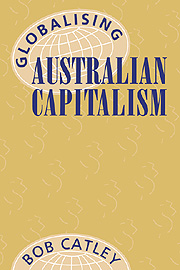Book contents
- Frontmatter
- Contents
- List of Tables
- List of Figures
- Preface and Acknowledgements
- List of Abbreviations
- Introduction
- 1 The International System and the End of the Cold War
- 2 The World Market and the Industrial Revolution in Asia
- 3 The Australian State and Economic Development
- 4 Economic Rationalism Changes Australian Politics
- 5 Government and Business in Australia
- 6 The Public Sector Reinvented
- 7 Australian Industry Restructures
- 8 Geographic Dimensions of Change
- 9 Australia Joins the Asia-Pacific Region: from ANZUS to APEC
- 10 All in a Day's Work
- Notes
- Index
5 - Government and Business in Australia
Published online by Cambridge University Press: 14 January 2010
- Frontmatter
- Contents
- List of Tables
- List of Figures
- Preface and Acknowledgements
- List of Abbreviations
- Introduction
- 1 The International System and the End of the Cold War
- 2 The World Market and the Industrial Revolution in Asia
- 3 The Australian State and Economic Development
- 4 Economic Rationalism Changes Australian Politics
- 5 Government and Business in Australia
- 6 The Public Sector Reinvented
- 7 Australian Industry Restructures
- 8 Geographic Dimensions of Change
- 9 Australia Joins the Asia-Pacific Region: from ANZUS to APEC
- 10 All in a Day's Work
- Notes
- Index
Summary
As a result of its decision to open its economy to the world market, Australia entered a new era as far as public policy towards private companies and business in general was concerned. In the past, private companies often looked to government to provide concrete support for profitable enterprise. This evolved into a complex but widespread system of interface between government and business, involving taxpayer subsidies by discounted inputs of land or energy, tariff protection from import competition, price support schemes, licensing arrangements, a heavily subsidised transport system, and wage regulation, to mention just a few mechanisms for intervention. As of 1983, it would have been difficult to assess the real level of efficiency of any particular sector or enterprise because the extent of cross-subsidisation was so extensive. It could only be posited, with some certainty, that domestic industry as a whole was not internationally competitive. In order to make it so it was necessary to disentangle the cross-subsidy system by a public policy agenda of dismantling it and simultaneously reporting on those sectors where subsidies were transparent enough to analyse. What was the cost of tariff protection of TCF to the consumer and hence to the economy as a whole? Did overstaffing at Telecom affect business communication costs? What was the real cost of road as against rail transportation of goods and how could both be improved? These issues touched at the heart of the relationship between government and business in Australia.
This relationship has attracted considerable attention in Australia during the period of deregulation, an interest deriving from a number of sources.
- Type
- Chapter
- Information
- Globalising Australian Capitalism , pp. 87 - 106Publisher: Cambridge University PressPrint publication year: 1996



